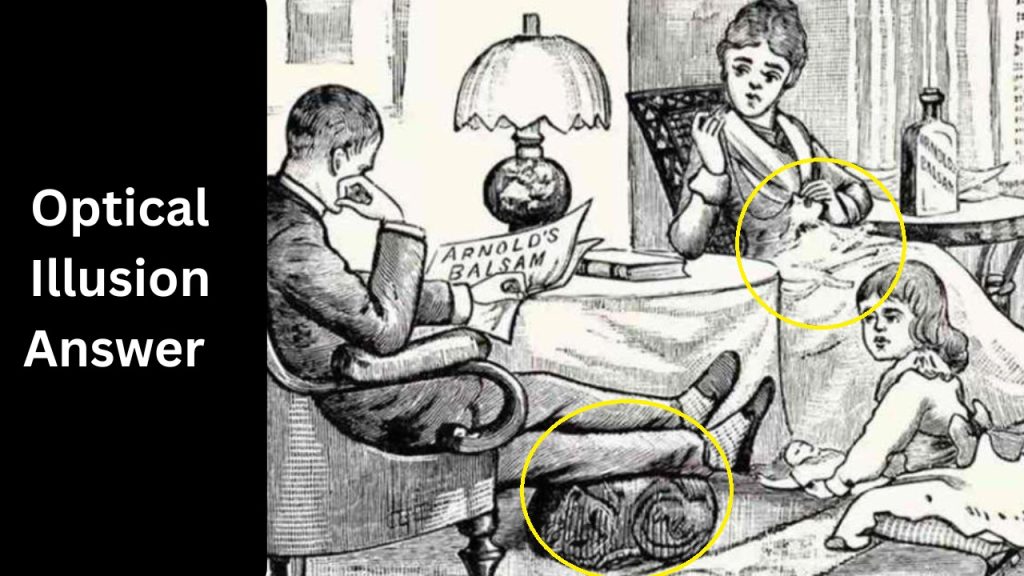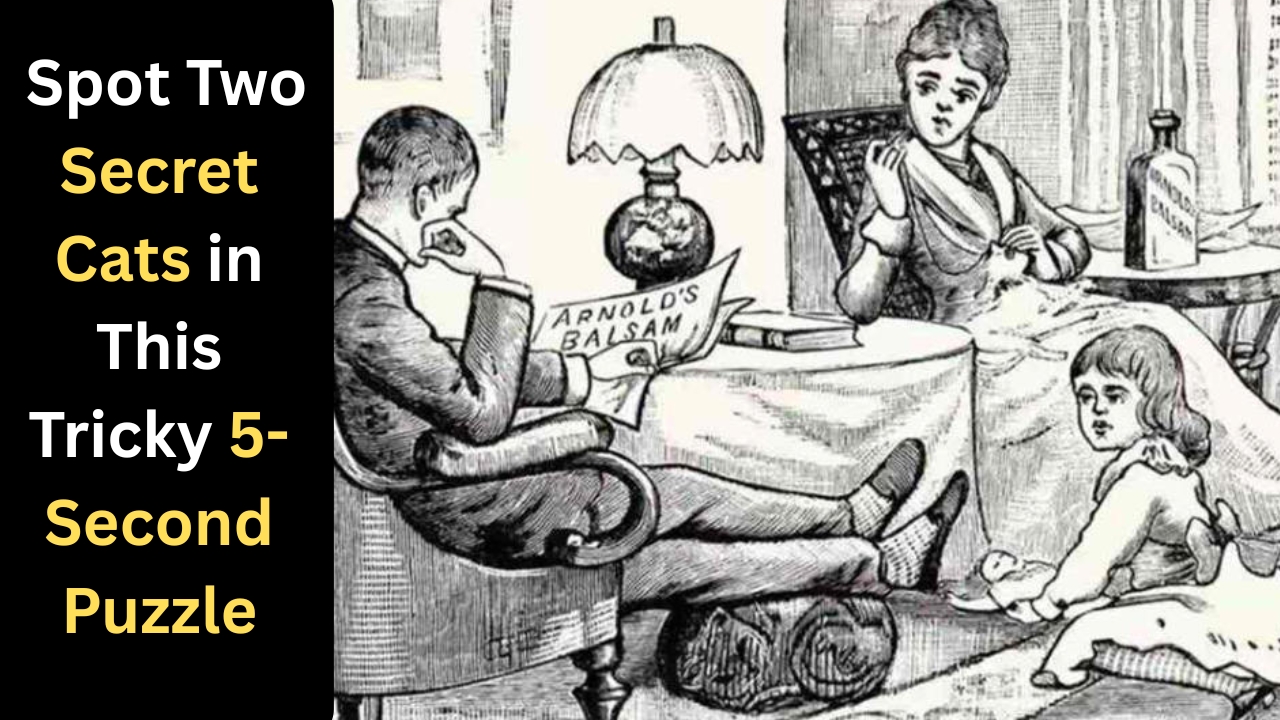Spot Two Secret Cats : The human brain possesses remarkable abilities when it comes to processing visual information, yet it can also be remarkably easy to deceive.
Optical illusions have fascinated scientists, artists, and puzzle enthusiasts for centuries, serving as windows into understanding how our minds interpret the world around us. Among the most engaging types of visual challenges are hidden object puzzles, particularly those that challenge us to find concealed animals within complex images.
Today, we explore the captivating world of optical illusions through a specific challenge that has been stumping viewers across the internet: finding two hidden cats within a seemingly ordinary image in just five seconds.
Understanding the Science Behind Visual Perception
Before diving into the specific challenge of locating hidden cats, it becomes essential to understand how our visual system processes information. When light enters our eyes, it strikes the retina, where millions of photoreceptor cells convert light waves into electrical signals.
These signals travel through the optic nerve to the visual cortex in our brain, where the real magic of interpretation begins.

The visual cortex doesn’t simply receive these signals passively. Instead, it actively constructs our perception of reality by filling in gaps, making assumptions, and applying learned patterns from our past experiences. This constructive process, while generally serving us well in daily life, creates opportunities for illusions to occur.
Our brains are pattern-seeking machines, constantly trying to make sense of visual input by comparing it to familiar shapes, objects, and concepts stored in our memory.
This pattern recognition system becomes particularly interesting when we encounter images designed to challenge our perceptual assumptions. Hidden object puzzles exploit the way our brains organize visual information into foreground and background elements, a process known as figure-ground segregation.
When artists cleverly design images where potential “figures” blend seamlessly with the “ground,” our usual perceptual shortcuts can work against us.
The Psychology of Hidden Object Recognition
The challenge of finding hidden cats within an image taps into several psychological principles that govern how we process visual information. One of the most significant factors is selective attention, which refers to our brain’s ability to focus on specific aspects of our environment while filtering out others.
In our daily lives, this selective attention helps us navigate complex visual scenes by highlighting what’s most relevant or important at any given moment.
However, this same mechanism can make hidden object puzzles particularly challenging. When we first look at an image, our attention naturally gravitates toward the most prominent or familiar elements. If the hidden objects are cleverly integrated into less obvious areas or disguised as parts of other objects, our initial scan might completely miss them.
This explains why some people can stare at a hidden object puzzle for minutes without success, while others might spot the concealed elements almost immediately.
The five-second time constraint adds another layer of complexity to the challenge. Under time pressure, our brains tend to rely even more heavily on quick pattern recognition and familiar shapes. This can be both helpful and hindering. Sometimes, the pressure forces us to trust our instincts and spot patterns we might overthink given more time. Other times, the rush prevents us from conducting the systematic visual search that might be necessary to locate well-hidden objects.
Strategies for Solving Hidden Cat Puzzles
Successful puzzle solvers often develop systematic approaches to tackle hidden object challenges. Rather than relying solely on quick glances or hoping for immediate recognition, effective strategies involve methodical visual scanning techniques that maximize the chances of discovery within the given timeframe.
One particularly effective approach involves dividing the image into smaller sections and examining each area systematically. Instead of trying to take in the entire image at once, which can overwhelm our visual processing system, breaking it down into manageable chunks allows for more thorough examination. This technique, known as grid searching, helps ensure that no area of the image goes unexamined.
Another valuable strategy focuses on looking for familiar cat features rather than complete cat shapes. Experienced puzzle solvers learn to identify partial elements that might indicate a hidden cat: the curve of an ear, the shape of eyes, the pattern of whiskers, or the distinctive silhouette of a feline form. Cats have very recognizable features, and often hidden cat puzzles will incorporate these distinctive elements even when the complete animal isn’t immediately obvious.
Color and contrast analysis also plays a crucial role in successful hidden object detection. Cats come in various colors and patterns, but they often have distinctive markings or color combinations that can stand out from their surroundings when you know what to look for. Training your eye to notice subtle differences in shading, texture, or color gradients can reveal hidden felines that blend into seemingly uniform backgrounds.
The Art of Creating Effective Hidden Object Illusions
Understanding how these puzzles are constructed can significantly improve your ability to solve them. Artists and puzzle creators employ various techniques to hide objects within images while maintaining the overall coherence and appeal of the scene. These techniques reveal important insights into how our visual system can be both challenged and deceived.
Camouflage represents one of the most common methods used to hide cats in optical illusions. Just as animals in nature use camouflage to blend with their environment, puzzle creators strategically place hidden cats in areas where their colors, patterns, or shapes naturally blend with surrounding elements. A tabby cat might be hidden among tree branches with similar striping patterns, or a black cat might be concealed in shadowy areas of the image.
Shape integration presents another sophisticated hiding technique. Rather than simply overlaying a cat image onto an existing background, skilled puzzle creators incorporate feline shapes into the natural contours and boundaries of other objects in the scene. A cat’s silhouette might form part of a rock formation, or the curve of a cat’s back might blend seamlessly with the horizon line of a landscape.
Negative space utilization offers yet another creative approach to hiding objects. In these designs, the cats aren’t necessarily drawn as positive elements in the image but instead emerge from the spaces between other objects. The background shapes and shadows combine to create the impression of feline forms, requiring viewers to shift their perspective and look at the image in an entirely different way.
Cognitive Benefits of Visual Puzzle Solving
Engaging with hidden object puzzles like the two-cat challenge provides numerous cognitive benefits that extend far beyond simple entertainment. These mental exercises serve as valuable training for various aspects of visual processing and cognitive function that we use throughout our daily lives.
Regular practice with visual puzzles enhances pattern recognition abilities, which prove useful in countless real-world situations. From quickly identifying important information in complex documents to recognizing faces in crowded environments, the skills developed through puzzle solving have broad applications. The systematic visual scanning techniques learned through hidden object puzzles can improve performance in professional settings that require careful attention to detail, such as quality control, medical imaging analysis, or security monitoring.
These challenges also provide excellent exercise for working memory and sustained attention. Keeping track of already-searched areas while maintaining focus on the current section requires coordination between different cognitive systems. Over time, this practice can lead to improvements in concentration and the ability to maintain focus for extended periods, skills that prove valuable in academic and professional pursuits.
The time pressure element of five-second challenges adds an additional dimension of cognitive training by exercising rapid decision-making abilities. Learning to quickly assess visual information and make efficient choices about where to direct attention develops skills that transfer to many high-pressure situations in daily life.
Cultural and Historical Context of Hidden Object Puzzles
The tradition of hiding objects within images has deep historical roots that span across cultures and artistic traditions. Ancient artists often incorporated hidden symbols, figures, and meanings into their works, creating layers of interpretation that rewarded careful observation. Religious art, in particular, frequently contained concealed imagery that conveyed additional spiritual or symbolic messages to those knowledgeable enough to recognize them.
In the modern era, hidden object puzzles gained widespread popularity through children’s books and magazines, where readers were challenged to find various items concealed within busy, detailed illustrations. These puzzles served educational purposes by encouraging careful observation skills while providing entertainment. The tradition evolved with technology, leading to computer games, mobile apps, and internet challenges that continue to engage millions of people worldwide.
The specific appeal of hidden animal puzzles, particularly those featuring cats, taps into our natural affinity for these creatures. Cats have been human companions for thousands of years, and our brains have become quite skilled at recognizing feline features and behaviors. This familiarity makes cat-finding puzzles both challenging and satisfying, as we feel confident in our ability to recognize these animals while still being surprised by clever concealment techniques.
Tips for Mastering the Five-Second Challenge
Successfully finding two hidden cats within a five-second timeframe requires a combination of preparation, technique, and practice. Understanding the specific constraints and opportunities presented by this challenge can significantly improve your success rate and overall enjoyment of the puzzle.
Preparation begins before you even look at the puzzle image. Take a moment to clear your mind and focus your attention entirely on the upcoming challenge. Eliminate distractions from your environment and ensure that you have good lighting and a clear view of the image. Mental preparation involves setting realistic expectations and remembering that success often comes with practice rather than immediate achievement.
Optical Illusion Challenges

When the timer starts, resist the temptation to frantically scan the entire image randomly. Instead, begin with a quick overall assessment to understand the general composition and identify the most likely hiding spots. Look for areas with appropriate colors, textures, or patterns that might camouflage feline shapes. Common hiding spots include shadowy areas, regions with organic textures, and boundaries between different elements in the image.
Focus your attention on recognizable cat features rather than trying to identify complete animals. Eyes often provide the most distinctive and easily recognizable elements, as they maintain their characteristic almond shape and positioning regardless of how the rest of the cat might be concealed. Ears represent another highly recognizable feature, with their triangular shape and typical positioning making them stand out even when partially hidden.
The Broader Appeal of Optical Illusions
The enduring popularity of optical illusions and hidden object puzzles reflects deeper aspects of human psychology and our relationship with perception. These challenges satisfy our natural curiosity about how our minds work while providing safe opportunities to experience the surprise and delight that come from discovering something unexpected.
On a social level, these puzzles create shared experiences that bring people together. The challenge of finding hidden cats becomes a communal activity where success can be celebrated and techniques can be shared. Social media has amplified this aspect, with millions of people sharing their results and discussing strategies for solving particularly challenging puzzles.
From an educational perspective, optical illusions serve as powerful tools for understanding the difference between objective reality and subjective perception. They demonstrate that what we see isn’t always an accurate representation of what exists, encouraging critical thinking about the nature of knowledge and experience. This lesson extends beyond visual puzzles to help develop healthy skepticism and analytical thinking in other areas of life.
The two hidden cats challenge represents just one example of how simple visual puzzles can engage multiple aspects of human cognition while providing entertainment and education. Whether you succeed in finding both cats within the five-second limit or require more time to locate them, the experience offers valuable insights into the remarkable capabilities and interesting limitations of human visual perception.
Through practice, patience, and systematic approach, anyone can improve their ability to solve these visual challenges while gaining deeper appreciation for the complex processes that govern how we see and interpret the world around us.
